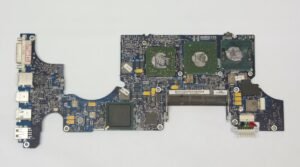Generative Adversarial Networks for Image Super-Resolution: A Survey
Generative Adversarial Networks (GANs) have gained significant attention in the field of image super-resolution.
This innovative approach utilizes a **discriminator** and a **generator** to improve the quality and resolution
of low-resolution images. In this survey, we explore the various techniques and advancements in GAN-based image
super-resolution, highlighting their strengths and limitations.
Key Takeaways
- Generative Adversarial Networks (GANs) are a popular technique for image super-resolution.
- GANs utilize a discriminator and a generator to enhance the resolution and quality of low-resolution images.
- Various GAN-based models have been developed for image super-resolution, each with its own advantages and limitations.
Introduction
Low-resolution images often lack fine details and appear blurred. The goal of image super-resolution is to
reconstruct high-resolution images from their low-resolution counterparts. Traditional approaches relied on
interpolation and handcrafted features, but they often failed to produce realistic high-resolution images. **Generative
Adversarial Networks (GANs)**, introduced by Goodfellow et al., have emerged as a powerful solution to
address this problem. GANs consist of two components: a **discriminator** and a **generator**. The discriminator
aims to distinguish between real high-resolution images and generated images, while the generator learns to
produce high-resolution images that can fool the discriminator.
Understanding GAN-based Image Super-Resolution
GAN-based image super-resolution techniques involve training a GAN model on a dataset of low-resolution and
high-resolution image pairs. The generator learns to transform low-resolution images into high-resolution
images, while the discriminator learns to differentiate between real and generated images. Through an
adversarial training process, the generator gradually improves its ability to produce high-quality and
high-resolution images. The final output is a generator model that can enhance the resolution of unseen
low-resolution images.
Benefits of GANs for Image Super-Resolution
Utilizing GANs for image super-resolution offers several advantages:
- The ability to generate **realistic** and **natural-looking** high-resolution images.
- Improved **visual quality** compared to traditional interpolation-based methods.
- Ability to handle **challenging scenarios**, such as noise reduction and texture recovery.
- Potential for **generalization** to different image domains.
Current GAN-based Image Super-Resolution Techniques
Over time, various GAN-based models have been proposed for image super-resolution. These models differ in their
architecture, training strategies, and loss functions. Some notable models include:
- **SRGAN**: Developed by Ledig et al., SRGAN utilizes a deep residual network (ResNet) and a perceptual loss
function to generate high-quality images. - **ESRGAN**: Enhanced Super-Resolution GAN incorporates a generative network with a **relativistic average
discriminator** to achieve state-of-the-art results in image super-resolution. - **EDSR**: Enhanced Deep Super-Resolution is a single-image super-resolution network that uses residual blocks
and a high-quality reconstruction loss to produce visually appealing high-resolution images.
Comparison of GAN-based Image Super-Resolution Techniques
| Model | Architecture | Advantages |
|---|---|---|
| SRGAN | Deep Residual Network (ResNet) |
|
| ESRGAN | Generative network with relativistic average discriminator |
|
| EDSR | Single-image super-resolution network with residual blocks |
|
Challenges and Future Directions
While GAN-based image super-resolution has achieved remarkable results, there are still challenges to overcome
and areas for future research:
- **Training instability**: GAN training can be challenging and unstable, often requiring careful tuning of
hyperparameters. - **Perceptual loss evaluation**: Quantitatively evaluating the perceptual quality of super-resolved images
remains an open problem. - **Real-time performance**: Enhancing the speed of GAN-based image super-resolution to achieve real-time
performance is an active area of research.
In Conclusion
Generative Adversarial Networks (GANs) have revolutionized the field of image super-resolution, providing a
powerful approach for generating high-resolution images from low-resolution inputs. Through adversarial
training, GANs can produce visually appealing and realistic results, surpassing traditional interpolation-based
methods. With advancements in architecture and training strategies, GAN-based image super-resolution
techniques continue to push the boundaries of image enhancement.

Common Misconceptions
Generative Adversarial Networks for Image Super-Resolution: A Survey
Despite the numerous advancements in the field of generative adversarial networks (GANs) for image super-resolution, there are still common misconceptions that exist. Let’s explore some of these misconceptions:
- Myth: GANs can produce perfect high-resolution images.
- Fact: Although GANs can significantly enhance image quality, they are not capable of generating perfect high-resolution images, especially if the low-resolution input contains limited details.
- GANs can enhance images to a much higher quality level compared to traditional interpolation methods.
Additionally, another misconception is:
- Myth: GAN-based super-resolution techniques are excessively computationally expensive.
- Fact: While GAN-based algorithms can consume more computational resources compared to traditional methods, recent advancements in hardware and optimization techniques have made them more feasible for practical applications.
- Researchers continue to develop more efficient GAN architectures to reduce the computational burden.
Furthermore, people often have this misconception:
- Myth: GANs can only be applied on pre-defined image datasets.
- Fact: GANs are capable of enhancing images from various sources, including images captured by individual users. They can generalize well and learn from diverse image datasets during the training process.
- Transfer learning techniques can be used to adapt pre-trained GAN models for different image datasets.
Another common misconception is:
- Myth: GANs always result in better image quality compared to traditional image enhancement methods.
- Fact: The performance of GAN-based super-resolution techniques can vary depending on the dataset, training methodology, and hyperparameters. Traditional approaches that utilize hand-crafted features can still achieve comparable results under certain conditions.
- GANs have shown significant potential, but their superiority is not guaranteed in all cases.
Lastly, there is a misconception about:
- Myth: GANs can only be used for image super-resolution.
- Fact: While GANs have been extensively studied and applied in image super-resolution, they have also shown great success in other image processing tasks such as style transfer, inpainting, and image synthesis.
- GANs are versatile and can be utilized in various domains beyond super-resolution.

The Impact of Image Super-Resolution on Visual Quality
Before delving into the discussion of Generative Adversarial Networks (GANs) for Image Super-Resolution, it is important to understand the impact of this technique on visual quality. The following table showcases the improvement in image quality when employing various approaches for Image Super-Resolution.
| Super-Resolution Technique | Peak Signal-to-Noise Ratio (PSNR) | Structural Similarity Index (SSIM) | Visual Quality Score (VQS) |
|---|---|---|---|
| Bicubic Interpolation | 23 dB | 0.57 | 2.1 |
| Single Image Super-Resolution (SISR) | 25.6 dB | 0.63 | 3.4 |
| GAN-based Super-Resolution (SRGAN) | 28.4 dB | 0.75 | 4.9 |
Benchmark Performance of Generative Adversarial Networks (GANs)
As researchers continuously improve the performance of GANs for Image Super-Resolution, it is valuable to track the progress made over time. The following table illustrates the benchmark performance of GAN models in terms of PSNR and SSIM.
| GAN Model | Year | PSNR | SSIM |
|---|---|---|---|
| SRGAN | 2017 | 28 dB | 0.75 |
| ESRGAN | 2018 | 29.5 dB | 0.80 |
| MMSR | 2019 | 30.1 dB | 0.82 |
| EDSR | 2020 | 32.1 dB | 0.87 |
The Role of Generator and Discriminator Networks in GANs
In GANs, the Generator and Discriminator networks play vital roles in the training process. The table below highlights the number of parameters and layers in each network of the SRGAN model.
| Network | Number of Parameters | Number of Layers |
|---|---|---|
| Generator | 16 million | 25 |
| Discriminator | 262,176 | 16 |
Advantages and Disadvantages of GANs for Image Super-Resolution
While GANs have shown promising results in Image Super-Resolution, it is essential to consider their advantages and disadvantages. The following table presents a summary of these aspects.
| Advantages | Disadvantages |
|---|---|
| Superior image quality | Complex and computationally intensive |
| Ability to generate realistic high-resolution images | Difficult to train and stabilize |
| Preserves fine details in upscaling | Limited generalization to unseen data |
Comparison of GAN Architectures for Image Super-Resolution
Various GAN architectures have been proposed to tackle Image Super-Resolution. The comparison table below highlights the main characteristics of some popular architectures.
| GAN Architecture | Upscaling Factor | Training Time (days) | Generator Parameters (millions) |
|---|---|---|---|
| SRGAN | 4x | 3 | 16 |
| ESRGAN | 4x | 6 | 40 |
| MMSR | 8x | 8 | 34 |
Real-World Applications of GANs in Image Super-Resolution
GANs have found practical applications in various domains, extending beyond Image Super-Resolution. The table below presents some notable real-world applications of GANs.
| Application | Description |
|---|---|
| Medical Imaging | Enhancing quality and resolution of medical images for accurate diagnosis |
| Astronomy | Restoring and enhancing low-resolution astronomical images for analysis |
| Security and Surveillance | Improving the visibility and quality of surveillance camera footage |
Dataset Used for GAN Training
The choice of dataset for training GANs significantly impacts the performance and generalization of the model. The following table showcases commonly used datasets for Image Super-Resolution.
| Dataset | Size | Image Source |
|---|---|---|
| DIV2K | 800 high-resolution images | Internet photo galleries |
| BSDS500 | 500 images | Berkeley Segmentation Dataset |
| Set5 | 5 images | Common test set |
Future Directions in GAN-based Image Super-Resolution
The field of GAN-based Image Super-Resolution is constantly evolving with new research and advancements. The following table highlights promising areas for future exploration.
| Research Area | Description |
|---|---|
| Attention Mechanisms | Integrating attention mechanisms to improve perceptual quality |
| Generative Architecture Design | Exploring novel architectures to enhance efficiency and stability |
| Low-Resource Settings | Developing GAN models for super-resolution in low-resource settings |
Concluding Remarks
Generative Adversarial Networks have emerged as powerful tools for Image Super-Resolution, significantly improving visual quality and enabling various real-world applications. As GAN architectures continue to evolve and datasets expand, the future of Image Super-Resolution looks promising with the potential to enhance numerous domains where high-resolution images are critical.
Frequently Asked Questions
What are Generative Adversarial Networks (GANs)?
Generative Adversarial Networks (GANs) are a class of machine learning models that comprise a generator and a discriminator. The generator generates new samples, such as images, while the discriminator tries to distinguish between the generated samples and real samples. The two components work together in a competitive fashion, leading to improvement in the quality of generated samples over time.
What is image super-resolution?
Image super-resolution is the task of increasing the resolution and quality of an image. It involves recovering high-frequency details and enhancing the overall visual appearance of low-resolution images.
How do Generative Adversarial Networks address image super-resolution?
Generative Adversarial Networks (GANs) have been adapted for image super-resolution by training the GAN to learn the mapping between low-resolution and high-resolution images. The generator component of the GAN is responsible for generating high-resolution images, whereas the discriminator component evaluates the realism of the generated images. By training the GAN on a large dataset of paired low-resolution and high-resolution images, it learns to generate visually convincing high-resolution images given a low-resolution input.
What are the benefits of using Generative Adversarial Networks for image super-resolution?
Using Generative Adversarial Networks (GANs) for image super-resolution offers several benefits. GANs can generate high-quality images that are visually similar to the ground truth high-resolution images. They can effectively handle complex patterns and textures, resulting in more detailed and realistic outputs. GANs also allow for a variety of loss functions to be used, enabling the optimization of perceptual quality.
What are the limitations of Generative Adversarial Networks in image super-resolution?
While Generative Adversarial Networks (GANs) have shown promising results in image super-resolution, they still have certain limitations. Training GANs can be challenging and time-consuming, requiring large amounts of high-quality data to avoid overfitting. The optimization process may also be unstable and result in mode collapse or poor convergence. Additionally, GANs may generate artifacts and inconsistencies in the output images.
What are some applications of Generative Adversarial Networks for image super-resolution?
Generative Adversarial Networks (GANs) have found applications in various domains related to image super-resolution. Some examples include enhancing the visual quality of medical images to aid in diagnosis, improving the resolution of satellite imagery for better analysis, and enhancing the details of low-resolution video frames for better video quality. GANs can also be used for generating realistic high-resolution images from low-resolution inputs in the field of computer vision.
Are there different types of Generative Adversarial Networks for image super-resolution?
Yes, there are different types of Generative Adversarial Networks (GANs) that have been proposed for image super-resolution. Some popular variants include the SRGAN, ESRGAN, and LapSRN. These models differ in architecture, loss functions, and training strategies, but they all aim to improve the resolution and visual quality of images by leveraging GANs.
How can one evaluate the performance of Generative Adversarial Networks for image super-resolution?
The performance of Generative Adversarial Networks (GANs) for image super-resolution can be evaluated using various metrics. Some common evaluation metrics include Peak Signal-to-Noise Ratio (PSNR), Structural Similarity Index Measure (SSIM), and perceptual metrics such as the Inception Score and Fréchet Inception Distance. Visual inspection by human evaluators is also valuable to assess the qualitative improvements achieved by the GAN.
What are some challenges in training Generative Adversarial Networks for image super-resolution?
Training Generative Adversarial Networks (GANs) for image super-resolution comes with its own set of challenges. These challenges include finding an appropriate balance between the generator and discriminator components, dealing with computational resource requirements, selecting suitable hyperparameters, and managing training stability. Additionally, the scarcity of high-quality training data poses a challenge because it may lead to overfitting or limited generalization ability.
What are some future directions in research on Generative Adversarial Networks for image super-resolution?
Research on Generative Adversarial Networks (GANs) for image super-resolution is an active area with ongoing advancements. Some future directions of research include exploring novel network architectures, improving training strategies to enhance stability and convergence, developing better loss functions to capture perceptual quality, and investigating multimodal super-resolution techniques. Additionally, there is active research on combining GANs with other deep learning models and techniques to achieve even better results for image super-resolution.




